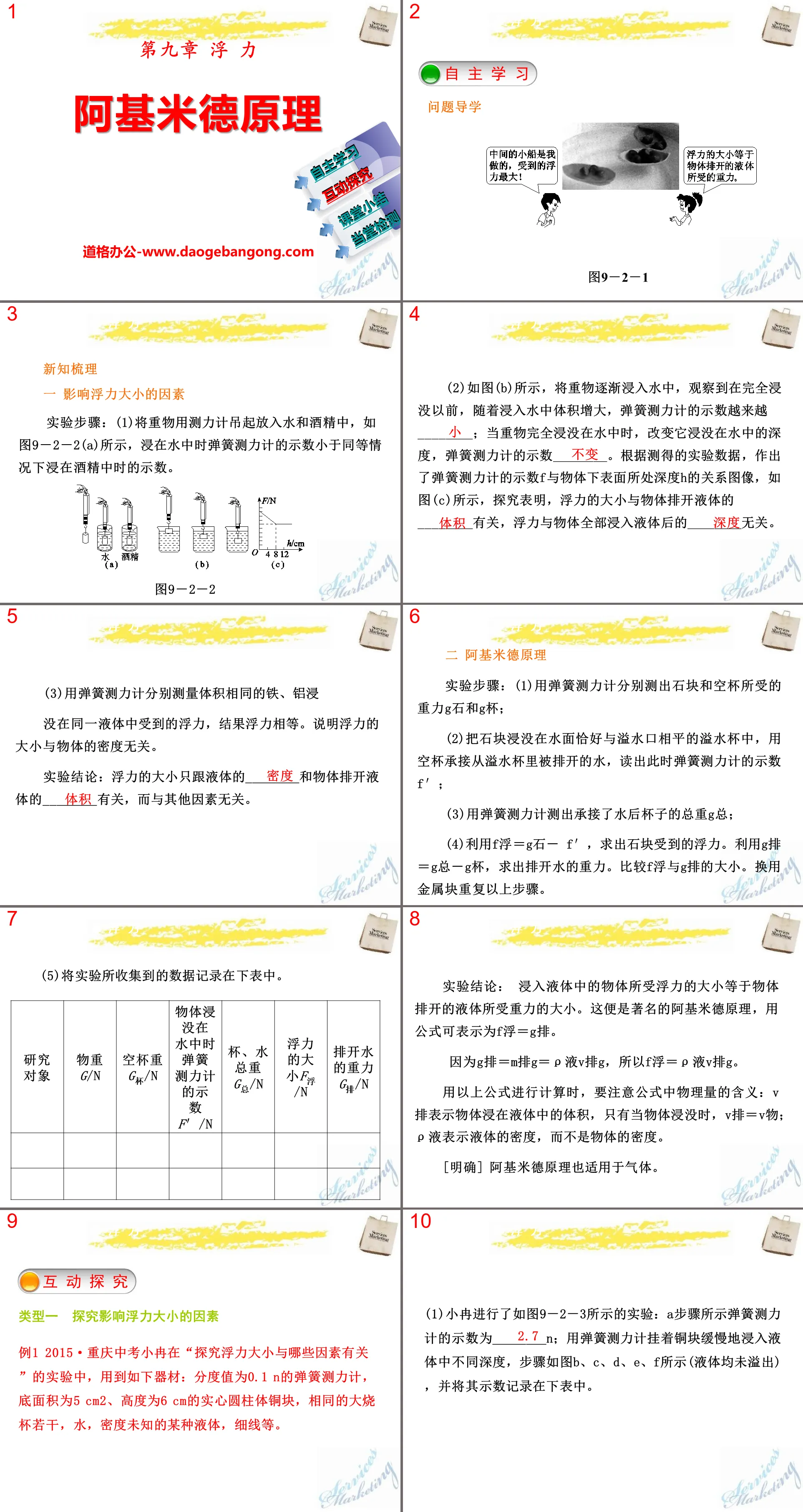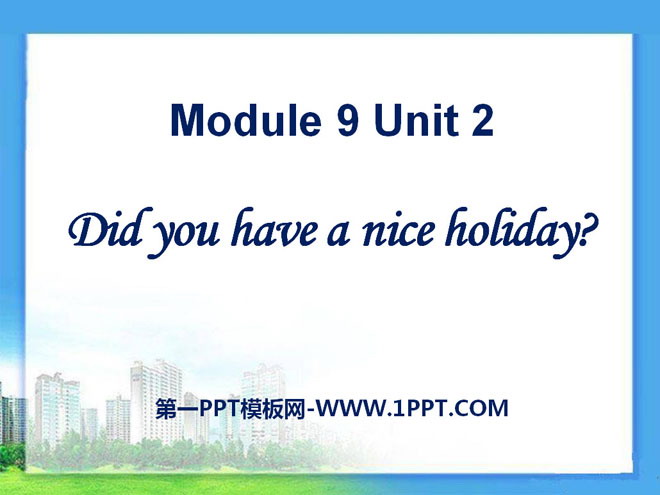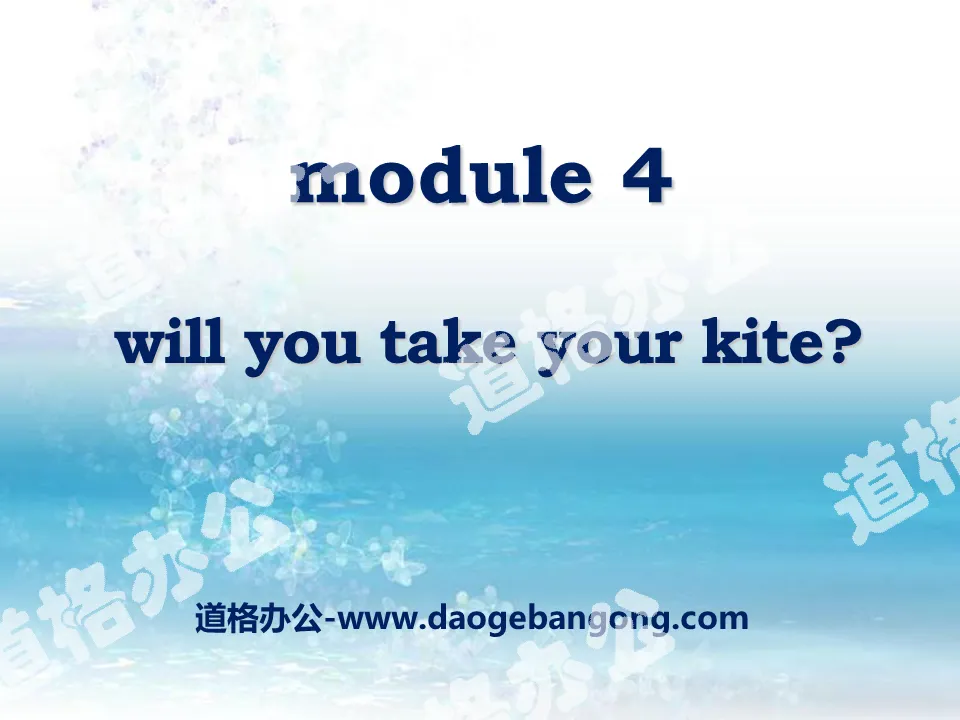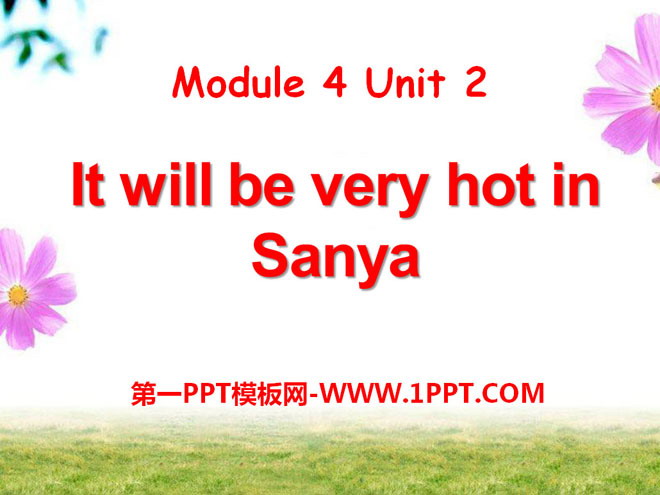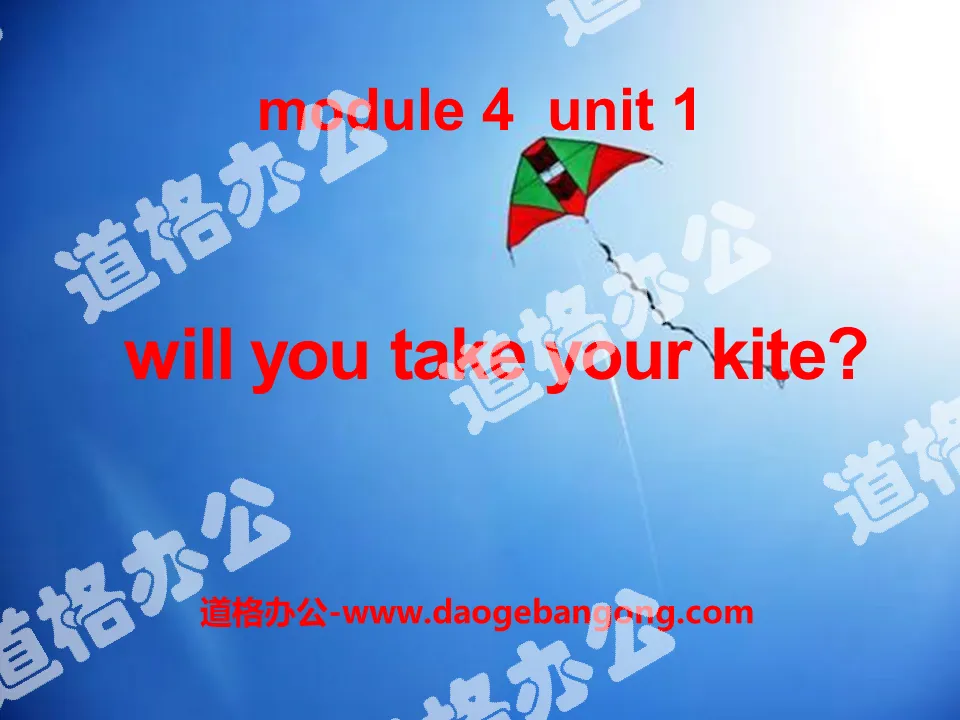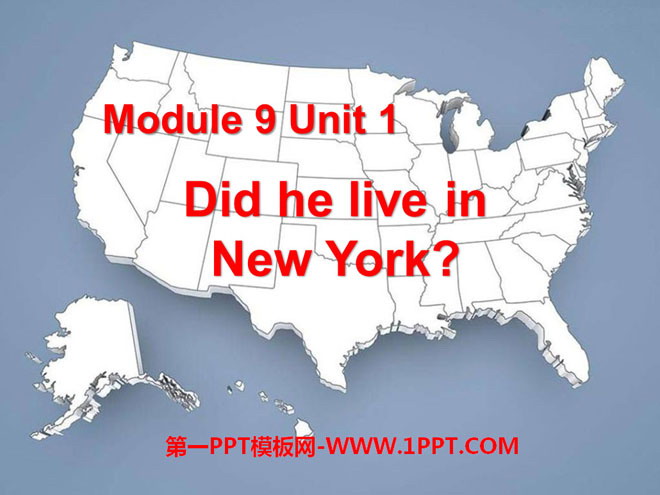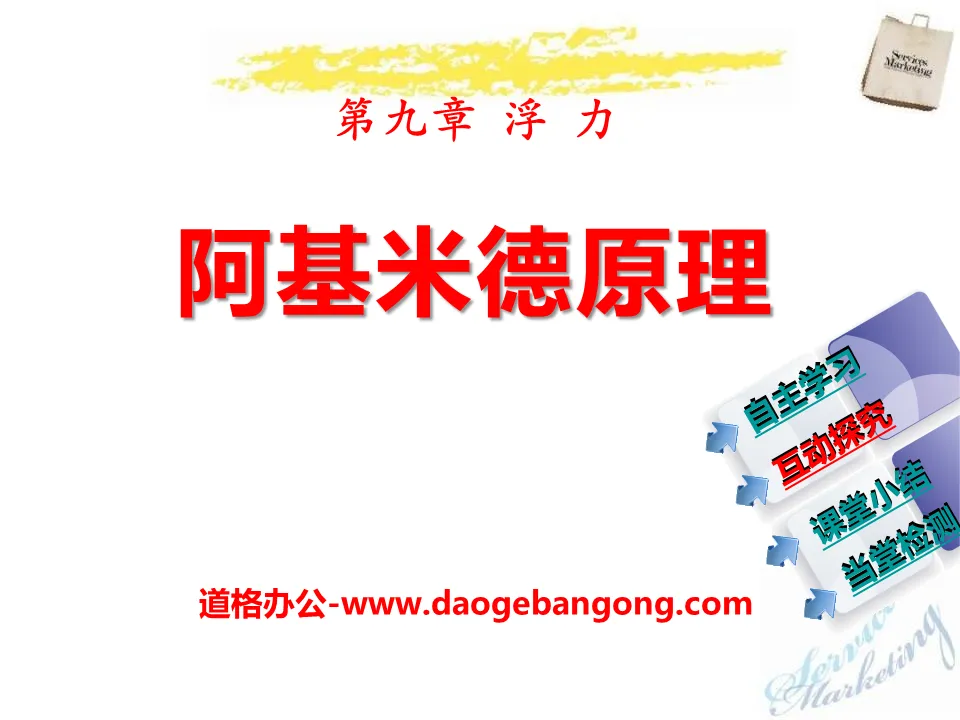
| Category | Format | Size |
|---|---|---|
| Shanghai Science Edition 8th Grade Physics | pptx | 6 MB |
Description
"Archimedes' Principle" Buoyancy PPT Courseware 6
Sorting out new knowledge
1. Factors affecting the size of buoyancy
Experimental steps: (1) Lift the weight with a dynamometer and put it into water and alcohol, as shown in Figure 9-2-2(a). When immersed in water, the reading of the spring dynamometer is smaller than that under the same circumstances. Display when immersed in alcohol.
(2) As shown in Figure (b), the weight is gradually immersed in water. It is observed that before the weight is completely immersed, as the volume of the immersion in the water increases, the indication of the spring force gauge becomes more and more ________; when the weight is completely immersed, When immersed in water, change the depth of immersion in the water, and the reading of the spring dynamometer is ________. Based on the measured experimental data, an image of the relationship between the indication F of the spring dynamometer and the depth h of the lower surface of the object was made, as shown in Figure (c). The study showed that the size of the buoyancy force is related to the ability of the object to displace liquid_ It is related to ______, but buoyancy has nothing to do with _______ after the object is completely immersed in the liquid.
(3) Use a spring dynamometer to measure the buoyancy force of iron and aluminum with the same volume immersed in the same liquid. The buoyancy forces are equal. Explain that the size of the buoyancy force has nothing to do with the density of the object.
Experimental conclusion: The size of the buoyancy force is only related to the _______ of the liquid and the _______ of the object displacing the liquid, and has nothing to do with other factors.
2. Archimedes’ Principle
Experimental steps: (1) Use a spring dynamometer to measure the gravity G on the stone and the empty cup respectively;
(2) Immerse the stone in an overflow cup whose water surface is exactly level with the overflow opening, use an empty cup to receive the water that is drained from the overflow cup, and read the indication F′ of the spring force gauge at this time;
(3) Use a spring dynamometer to measure the total weight G of the cup after receiving water;
(4) Use F float = G stone - F′ to find the buoyant force on the stone. Use G row = G total - G cup to find the gravity of the displaced water. Compare the size of F float and G row. Repeat the above steps using a metal block instead.
Experimental conclusion: The buoyancy force on an object immersed in a liquid is equal to the gravity of the liquid displaced by the object. This is the famous Archimedes principle, which can be expressed as F float = G row.
Because G row = m row g = ρ liquid V row g, so F float = ρ liquid V row g.
When calculating with the above formula, pay attention to the meaning of the physical quantities in the formula: V row represents the volume of the object immersed in the liquid. Only when the object is immersed, V row = V object; ρ liquid represents the density of the liquid, not the density of the object .
[Clearly] Archimedes' principle also applies to gases.
Interactive exploration
Type 1: Explore the factors that affect the size of buoyancy
Example 1 2015·Chongqing High School Entrance Examination Xiao Ran used the following equipment in the experiment of "exploring the factors related to the size of buoyancy": a spring dynamometer with a graduation value of 0.1 N, a bottom area of 5 cm2, and a height of 6 cm. Solid cylindrical copper block, several identical large beakers, water, some kind of liquid with unknown density, thin wires, etc.
(1) Xiaoran conducted the experiment shown in Figure 9-2-3: the spring dynamometer indicated in step A is ________N; a copper block was hung from the spring dynamometer and slowly immersed in the liquid at different depths , the steps are shown in Figures B, C, D, E, and F (no liquid overflowed), and record the readings in the table below.
(2) In experimental step B, the buoyancy force F on the copper block = ______N.
(3) Analyzing the experimental steps A, B, C and D, it can be shown that the buoyancy is related to _______; analyzing the experimental steps A, E, F, it can be shown that the buoyancy is related to _______.
(4) Xiaoran used the data in the table to calculate the density of a certain liquid to be ______kg/m3 (retaining the result to one decimal place). He also calculated the pressure of water on the lower surface of the copper block in step B to be ______Pa, and found that In steps B, C, and D, the pressure of water on the lower surface of the copper block gradually ______ (optional "increase" or "decrease") as the depth increases.
Example 2 When exploring "what factors are related to the size of buoyancy?" the students put forward the following conjectures:
A. It may be related to how deeply the object is immersed in the liquid;
B. It may be related to the volume of liquid displaced by the object;
C. It may be related to the density of the liquid;
D. It may be related to the density of the object.
In order to verify the above conjecture, Li Ming performed the experiment shown in Figure 9-2-4A: He hung an iron block at the lower end of the spring dynamometer and slowly immersed it in different positions in the water. In the process:
(1) When the iron block moves from position 1→2→3, the indication of the spring dynamometer is _____, which shows that the buoyancy force on the iron block is _______; when it moves from 3→4, the indication of the spring dynamometer is The number of _______ indicates that the buoyant force on the iron block is _______. (Please choose "get bigger", "get smaller" or "unchange")
(2) Through the above experiments, it can be verified that the above conjecture ______ (fill in the letters of the conjecture above) is correct.
(3) As shown in Figure B, fresh eggs will sink when placed in water. Add salt to the water one after another and stir gently. You will find ________. This phenomenon illustrates the above guess _____ (fill in the letters of the guess above) )is correct.
On-site testing
Knowledge point 1: Explore the factors that affect the size of buoyancy
1. Figure 9-2-6 shows the experimental process diagram used to explore the factors related to the buoyancy force experienced by the same object. The experiments in Figure _______ and Figure _______ can be used to explore the differences between objects immersed in liquid. Are the buoyancy forces at depth equal?
2. Xiao Ming used a spring dynamometer, a metal block, and two identical beakers (containing a certain amount of water and kerosene respectively) to explore the buoyancy force on objects immersed in liquid. Figure 9-2-7 shows the exploration process and related data.
(1) Analyze Figures B, C, and D to show that the size of the buoyancy force is related to _______________.
(2) The analysis diagram ______ shows that the buoyancy force is related to the density of the liquid.
(3) The buoyant force on an object completely immersed in kerosene is ________N.
(4) Xiao Ming also wants to explore whether the size of the buoyancy force is related to the shape of the object. Please briefly describe the experimental method.
[Answer] (4) Experimental method: Control variable method.
Experimental equipment: spring dynamometer, a piece of plasticine, a beaker filled with enough water, and thin wire.
Experimental steps: ① Tie the plasticine with a thin wire, hang it on the hook of the spring dynamometer, immerse the plasticine in water, and read the indication F1 of the spring dynamometer;
② Knead the plasticine into different shapes, immerse it in water, and read the reading F2 of the spring dynamometer;
③ Compare the sizes of F1 and F2 to draw conclusions.
Keywords: buoyancy teaching courseware, Archimedes Principle teaching courseware, Shanghai Science Edition eighth grade physics PPT courseware download, eighth grade physics slide courseware download, buoyancy PPT courseware download, Archimedes Principle PPT courseware download,. PPT format;
For more information about the PPT courseware "Archimedes' Principle of Buoyancy", please click the Buoyancy ppt Archimedes Principle ppt tag.
"Archimedes' Principle" Buoyancy and Lift PPT courseware:
"Archimedes' Principle" Buoyancy and Lift PPT courseware teaching objectives 1. Know Archimedes' Principle through experimental exploration; 2. Be able to use Archimedes' Principle to solve problems related to buoyancy. Teaching focus: Archimedes' Principle thinking activation A wooden block is placed on a level surface...
"Archimedes' Principle" Buoyancy PPT Courseware 8:
"Archimedes' Principle" Buoyancy PPT Courseware 8 1. Review 1: What is buoyancy? Design experiment: As shown in the figure, use a spring dynamometer, a block, a thin wire, a beaker, water and other equipment to compare the readings of the spring dynamometer when the block is in air and water. Steps: (1) In...
"Archimedes' Principle" Buoyancy PPT Courseware 7:
"Archimedes' Principle" Buoyancy PPT Courseware 7 Archimedes' Inspiration More than two thousand years ago, the Greek scholar Archimedes wanted to measure the volume of a gold crown in order to identify whether it was pure gold. He thought hard for a long time but failed. result. One day, he stepped into a bathtub filled with water...
File Info
Update Time: 2024-07-29
This template belongs to Physics courseware Shanghai Science Edition 8th Grade Physics industry PPT template
"Archimedes' Principle" Buoyancy PPT Courseware 6 Simple campus recruitment activity planning plan summary enterprise and institution recruitment publicity lecture PPT template is a general PPT template for business post competition provided by the manuscript PPT, simple campus recruitment activity planning plan summary enterprise and institution recruitment promotion Lecture PPT template, you can edit and modify the text and pictures in the source file by downloading the source file. If you want more exquisite business PPT templates, you can come to grid resource. Doug resource PPT, massive PPT template slide material download, we only make high-quality PPT templates!
Tips: If you open the template and feel that it is not suitable for all your needs, you can search for related content "Archimedes' Principle" Buoyancy PPT Courseware 6 is enough.
How to use the Windows system template
Directly decompress the file and use it with office or wps
How to use the Mac system template
Directly decompress the file and use it Office or wps can be used
Related reading
For more detailed PPT-related tutorials and font tutorials, you can view: Click to see
How to create a high-quality technological sense PPT? 4 ways to share the bottom of the box
Notice
Do not download in WeChat, Zhihu, QQ, built-in browsers, please use mobile browsers to download! If you are a mobile phone user, please download it on your computer!
1. The manuscript PPT is only for study and reference, please delete it 24 hours after downloading.
2. If the resource involves your legitimate rights and interests, delete it immediately.
3. Contact information: service@daogebangong.com
"Archimedes' Principle" Buoyancy PPT Courseware 6, due to usage restrictions, it is only for personal study and reference use. For commercial use, please go to the relevant official website for authorization.
(Personal non-commercial use refers to the use of this font to complete the display of personal works, including but not limited to the design of personal papers, resumes, etc.)
Preview
